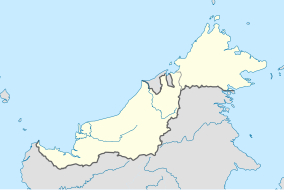Lambir Hills National Park
| Lambir Hills National Park Taman Negara Bukit Lambir |
|
|---|---|
|
IUCN category II (national park)
|
|

Dense understorey of mixed dipterocarp forest in the park
|
|
| Location | Sarawak, Malaysia |
| Nearest city | Miri |
| Coordinates | 4°12′47″N 114°01′48″E / 4.213°N 114.03°ECoordinates: 4°12′47″N 114°01′48″E / 4.213°N 114.03°E |
| Area | 6,952 ha (17,180 acres) |
| Established | 1975 |
| http://www.sarawakforestry.com/htm/snp-np-lambir.html | |
The Lambir Hills National Park (Malay: Taman Negara Bukit Lambir) is a national park in Miri Division, Sarawak, Malaysia, on the island of Borneo. It is a small park, at 6,952 hectares (17,180 acres), and is composed largely of mixed dipterocarp forest, with some small areas of 'kerangas' (heath forest). The park is 150–465 m (492–1,526 ft) above sea level.
Biologists have recorded 237 species of birds, 64 species of mammals, 46 species of reptiles and 20 species of frogs in the national park. Large mammals such as gibbons and sun bear are absent or very rare due to the small size of the forest and illegal hunting. More recent surveys (2003–2007), however, failed to find 20% of the park’s resident bird species and 22% of the mammal species, losses that include half of the park’s primate species and six out of seven hornbill species. Collapse in population of large mammals and birds is an ecological disaster in Lambir.
The park's invertebrates include the Rajah Brooke's Birdwing butterfly (Trogonoptera brookiana) and more than 300 species of ants. Leeches are rare.
In 1991, the Sarawak Forest Department, Center for Tropical Forest Science/Harvard University, and the Plant Ecology Laboratory of Osaka City University, Japan created the Lambir Hills Forest Dynamics Plot. This is a 52-hectare (130-acre) area of the forest in which all trees thicker than 1.5cm at breast height have been measured, mapped and identified. Every few years, researchers do a census of these trees so they can track their growth and changes in the population structure of each species. A census of all trees in the plot found 1175 different species. This gives Lambir Hills National Park possibly the highest diversity of trees of any forest in the Old World.
The dominant family of trees in the park is the Dipterocarpaceae, whose members include Shorea and Dryobalanops species. As Lambir Hills National Park is the last intact patch of lowland dipterocarp forest left in Sarawak it is an important refuge for species that have been heavily logged elsewhere.
...
Wikipedia

